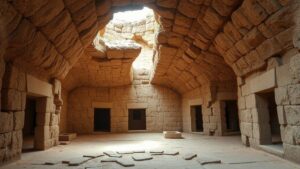Using seismic technology to detect buried structures beneath deserts in North Africa.
Using Seismic Technology to Detect Buried Structures Beneath Deserts in North Africa
In recent years, seismic technology has transformed the field of archaeology, particularly in arid environments such as the deserts of North Africa. This region, known for its ancient civilizations and remarkable historical significance, presents unique challenges for archaeological exploration. But, advancements in seismic methods allow researchers to penetrate the earths crust and uncover buried structures that may date back thousands of years.
The Importance of Seismic Technology
Seismic technology relies on the principles of wave propagation through the earth. By generating mechanical waves–often produced by small explosives or vibroseis trucks–scientists can analyze the way these waves travel through different types of soil and rock. Variabilities in the propagation speed and amplitude of these waves provide valuable information about what lies beneath the surface.
Seismic methods are particularly useful in North Africa for several reasons:
- Desert environments often lack vegetation, making traditional excavation difficult and labor-intensive.
- Ancient structures may be buried under thick layers of sand, complicating their discovery.
- Seismic technology can cover large areas quickly, making it cost-effective and efficient.
Applications in North Africa
The application of seismic technology in North Africa has yielded significant results in various archaeological projects. For example, in 2020, archaeologists utilized seismic reflection methods in the Algerian Sahara to locate the remains of a Roman villa buried beneath sand dunes. application of advanced processing techniques revealed the outlines of the structure, leading to a successful excavation that produced an array of artifacts, including Roman pottery and coins.
Case Study: The Saqqara Necropolis, Egypt
Another prominent example is the Saqqara necropolis in Egypt, renowned for its ancient burial sites, including the famous Step Pyramid of Djoser. In 2021, researchers employed seismic imaging to explore potential undiscovered tombs in the vicinity of this site. The exploration led to the detection of various anomalies, suggesting the presence of additional burial chambers close to the surface.
By using seismic data, the team was able to create a three-dimensional model of the subsurface, which guided anchoring excavation efforts. This approach not only saves time but also minimizes the disturbance of the surrounding environment.
Challenges and Limitations
Despite its benefits, the use of seismic technology is not without challenges. One major concern is the interpretation of data. While seismic waves can indicate the presence of structures, they cannot definitively determine the materials or their historical context. Acoustic features may suggest human-made structures but also risk misidentification as natural formations.
Also, extreme weather conditions in deserts can influence the quality of seismic readings. Sand dunes shift frequently, and sudden rainfall can create temporary alterations in the subsurface conditions, complicating data analysis.
The Future of Seismic Technology in Archaeology
As technology continues to advance, the future of seismic exploration in North Africa appears promising. Innovations in machine learning and artificial intelligence are beginning to enhance data interpretation, allowing researchers to make more accurate predictions about potential archaeological finds. For example, algorithms can analyze seismic signatures more effectively by considering historical context and the common characteristics of ancient structures.
Also, collaborative efforts between geological and archaeological experts may further refine seismic methodologies, enabling scholars to unlock the ancient mysteries buried beneath the desert sands.
Actionable Takeaways
For modern archaeologists working in North Africa, adopting seismic techniques can drastically enhance the efficiency of exploration efforts. To capitalize on this emerging technology, professionals should:
- Stay updated on advancements in seismic methods and integrate them into research planning.
- Collaborate across disciplines, incorporating geologists and engineers into archaeological teams.
- Use data analytics to improve interpretation of seismic data, enhancing the potential for discovery.
To wrap up, the application of seismic technology to detect buried structures beneath the deserts of North Africa represents a revolutionary leap in archaeological methodology. As the sophistication of these technologies evolves, they hold the potential to reveal rich histories that have long remained hidden beneath the sands of time.



